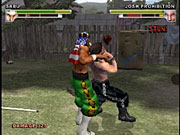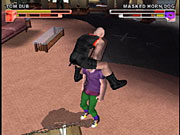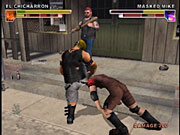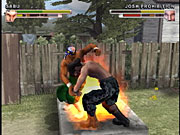In an attempt to appeal to the fans of wrestling games who have grown somewhat weary of the less-than-stellar WWE products, numerous companies have been licensing their own non-WWE wrestling games. Everyone is starting to get in on the fray, including EA, Bandai, and, now, Eidos Interactive. Developed by Paradox Entertainment, the development house behind the Wu-Tang: Shaolin Style and Activision's X-Men fighting games, Eidos' first effort into the wrestling genre is Backyard Wrestling: Don't Try This at Home. The game is licensed by the Backyard Wrestling franchise, which specializes in DVDs that compile footage of average kids bludgeoning each other with every blunt object they can find in the relative comfort of their own yards. While Backyard Wrestling certainly has qualities that could make for an interesting wrestling game, Don't Try This at Home is so unpolished that it's far more of a chore than a pleasure to play.

Backyard Wrestling doesn't actually feature any teenage grapplers from actual backyard wrestling federations. Instead, what it does feature is a collection of independent federation wrestlers, including a number of talents from rap group Insane Clown Posse's own wrestling federation, the JCW. Some featured wrestlers include Mad Man Pondo, Sabu, Tom Dub, Rude Boy, Josh Prohibition, MDogg20, and the wicked clowns themselves, Violent J and Shaggy 2 Dope. Other noted appearances include Miller Lite spokesmodel Kitana Baker and former WCW valet Tylene Buck. Considering the license, it only makes sense that you won't be wrestling inside a ring of any sort in the game, and, aside from the standard backyards, you'll also have a truck stop, a slaughterhouse, an outdoor parking lot, a talk show set, and a strip club at your disposal. Every environment is littered with barbed wire-laden bats, fluorescent light bulbs, breakable tables, steel chairs, and pretty much any other object you could possibly think of to use for injuring an opponent.
In between the barbed wire maulings, you also have to occasionally wrestle in Backyard Wrestling. The wrestling mechanics aren't all that dissimilar to most recent wrestling games. You have two strike buttons as well as a grapple button, and you also have a button that picks up weapons. When you're grappling an opponent, pressing a direction on the analog stick, along with one of the strike buttons, performs a striking grapple or a slam, depending on which button you hit. You also have a unique special move that can be performed when your life meter begins flashing red. Grappling an opponent and then pressing both strike buttons while the meter is flashing performs this move. Aside from the ability to drag a fallen opponent around the level and the option of climbing onto tall ledges to leap onto your foes, that's about all there is to the wrestling portion of the game. Although the system isn't very deep, it's serviceable for the type of game it is. In fact, the biggest problem is not the system itself, but, rather, it's the execution of it.

When you're playing Backyard Wrestling, everything in the game feels extremely loose, repetitive, and sloppy. Moving your character around can be a bit of a task, as the analog stick's sensitivity level is pretty unforgiving. So, for the most part, all you'll be doing in the game is running around at full speed. This can be a bit unwieldy when trying to approach an opponent. Another problem is that matches never feel particularly engaging. All you have is a standard life meter--the match ends when it's depleted--and there are no real momentum swings or any other wrestling-like elements to be found. You have the option of pinning your opponent at any time. However, the only time you can generally get a successful three-count is after you've dropped your opponent's life bar to practically nothing, so it doesn't serve much purpose. In effect, all you'll be doing is running around the level for a couple of minutes at a time, beating people with random objects and occasionally suplexing them. As you can imagine, after the initial novelty wears off, this becomes very dull.
Add to this the fact that there just isn't much to do in Backyard Wrestling. The game's main feature is the talk show mode, which basically acts as the game's story or season mode. Here you have to play through a number of survival-type matches against multiple opponents in each level. These matches are interspersed with cutscenes that take place on a fictional talk show called "Today's Topic," where today's topic is, of course, Backyard Wrestling. The show's host interviews a number of different guests, including a billionaire who allows his son to participate in backyard wrestling in his mansion's backyard, and the Insane Clown Posse, who lament about backyard wrestlers inadvertently destroying their tour bus. Unfortunately, none of these interviews are particularly funny, despite being overtly tongue-in-cheek. In fact, nothing about the talk show mode is terribly worthwhile, except that completing it a couple of times will unlock all of the game's hidden wrestlers. The whole mode is only a couple of hours long, so once you've unlocked everybody, there's no real reason to ever go back and play it again.

Aside from the talk show mode, you can play through a quick exhibition match against the CPU or a friend. You can play a couple of bonus games, like a king-of-the-hill game where you must occupy a highlighted space in a level while staving off attacks from your opponent. There's a game of tag where the player who is "it" has his or her life meter periodically drained until he or she can knock down the opposing player and tag him or her as "it." There's also a very marginal create-a-wrestler mode where you can choose from about 15 prerendered character models, edit their move lists, and change their basic costume colors. None of the bonus games really add anything to the game, since they are just as prone to banality as the rest of the game. The create-a-wrestler mode is amazingly lacking when compared to the create-a-wrestler mode in other games. The game is also playable by two players, but the two player game suffers from the same problems as the single-player, so there really isn't much fun to be had here, either. Ultimately, Backyard Wrestling just doesn't have much to offer in the way of variety or entertaining gameplay.
Backyard Wrestling is also a pretty unimpressive-looking game. The wrestling environments are reasonably spacious, and contain plenty of destructible elements to ram your opponents into, but, aside from these aspects, none of them look very good. Unfortunately, the ability to clip heavily through pretty much any solid object is rampant throughout. The wrestler models are pretty light on detail, though one nice thing is that they look progressively bloodier and beaten as the match goes on. All of the game's moves are highly exaggerated, in the same vein as Def Jam Vendetta, and, although they aren't quite as impressive as Vendetta's, they're still amusing to watch. The biggest graphical problem is the game's camera, which is incredibly unstable and frequently begins vibrating violently in close-up shots. The game also has some pretty notable glitches, like wrestlers who get stuck running in one spot, thus trapping them until you hit them or move to an angle where they can escape. Additionally, there's a bug we noticed on a couple of occasions in the talk show mode where starting the mode with a new character causes him or her to load as a textureless skeletal model. This would fix itself after a while--and wasn't something that was easy to re-create--but it did happen more than once. The Xbox version of the game is decisively better looking, with much cleaner, brighter textures and a far more consistent frame rate. Additionally, most of the glitches found in the PS2 version don't seem to happen in the Xbox game--although wrestlers still periodically get stuck in sections of the game's levels.
The game's sound is its strongest feature, but this is largely due to its robust soundtrack. The game features more than 40 songs in all, from a multitude of punk, nu-metal, rap, and hardcore acts, like Andrew WK, Rancid, the Dropkick Murphys, Masters of Illusion, CKY, Chimaira, Further Seems Forever, Sum 41, American Hi-Fi, The Rise, Machine Head, Biohazard, Anthrax, Sepultura and, predictably, the Insane Clown Posse. The Xbox version also supports custom soundtracks. Aside from the soundtrack, though, there isn't much else to the audio presentation. The in-game sound effects are all pretty mediocre and lack any sounds that would give you a particularly good sense of the brutality of the weapon hits you're delivering. The voice work in the game is passable in the cutscenes (despite the lack of intended humor), but it's unintelligible during the wrestlers' intros.

To sum it all up, Backyard Wrestling: Don't Try This at Home is basically a failed experiment. It does its best to try to be something different, and it does marginally succeed at this task. Despite being different, however, it also lacks the depth found in most modern wrestling offerings--both in gameplay and modes--and really won't satisfy the average fighting or beat-'em-up fan, either. Unfortunately, its lengthy laundry list of aggravating problems prevents it from being of even casual interest to wrestling fans on the hunt for diversity in their wrestling game libraries. Perhaps there's still potential for the Backyard Wrestling license in future releases, since the basic concepts for the game are inherently sound. However, there's simply no salvaging Don't Try This at Home, and, ultimately, it should be avoided.